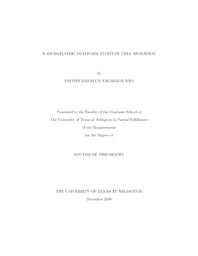
ATTENTION: The works hosted here are being migrated to a new repository that will consolidate resources, improve discoverability, and better show UTA's research impact on the global community. We will update authors as the migration progresses. Please see MavMatrix for more information.
Show simple item record
| dc.contributor.author | Malalur Nagaraja Rao, Smitha | en_US |
| dc.date.accessioned | 2012-04-11T20:54:40Z | |
| dc.date.available | 2012-04-11T20:54:40Z | |
| dc.date.issued | 2012-04-11 | |
| dc.date.submitted | January 2009 | en_US |
| dc.identifier.other | DISS-10459 | en_US |
| dc.identifier.uri | http://hdl.handle.net/10106/9524 | |
| dc.description.abstract | Migration of cancer cells from the primary organ to distant sites is critical to the development of malignant metastasis. This is partly dependant on the various chemical factors present in the blood serum. Cell motility studies using conventional Boyden chamber assays require high volumes of reagents. The measurement provides only an end-point result and time-lapse study of the cell deformation and migration cannot be performed. We have designed and evaluated a poly-dimethylsiloxane (PDMS) microfluidic device in order to study cell migration in the presence of gradients. Photolithography and soft lithography processes were used to fabricate the PDMS devices from the negative photoresist (SU-8) molds. The devices were then soft bonded to standard tissue culture plates. Conventional tissue culture techniques were employed and the cell culture environment was not compromised. Using our proposed designs, we can obtain cell number, location, migration rate and time taken for cells to migrate in response to chemoattractants. We propose two different methods to study cell migration in response to chemokine gradients. In the first method, the chemokines were continuously infused into the microfluidic system through a system of microchannels creating a sustainable gradient and migration of cells in this gradient environment was monitored. Migration of cells in this gradient environment was monitored. This device consists of three inlets and one outlet. The inlets were used to introduce chemokines along with culture media and cells in suspension. Time lapse video micrographs were used to determine concentration gradients and cell response in the gradients. The channels were designed to be 100 micrometer wide and micrometer in height with two mixing stages leading into the outlet. The outlet was designed to be 900 micrometer wide and 100 micrometer in height. In the second method, the gradient was formed by diffusion over time in the microchannels after the chemoattractants were introduced. The device consists of two separate identical chambers that are interconnected by identical microchannels that are 10 micrometer high, 25 micrometer wide and 1 mm long. One chamber contains cancer cells whose migration characteristics are to be evaluated, while the other chamber contains media with chemoattractants towards which the response of the cancer cells needs to be analyzed. Time-lapse photography was used to determine the migration of cells in the microchannels and obtain information regarding migration rate, cell number and identify migration potential of various stimulants. Two such designs were tested. In the first one had four reservoirs, two each for cell seeding and addition of chemoattractants. This reduced chemokine consumption compared to conventional assays however, we aimed to further reduce the volume of reagents required. The third design had only one reservoir each for cell seeding and addition of chemoattractants.Several cell lines were tested against various factors. Normal human epithelial prostate (HPV-7) cells were tested against growth factors. Similarly, Prostate cancer (PC-3) cells, lung metastasized prostate cancer cells (PC-3-ML), breast cancer cells (MDA-MB-231), Normal human mesangial (HMC) cells, Kidney cancer (CaKi-2) cells were all tested against several antibodies and ionic chemicals. The migrationrate, distance and cell numbers for each case were determined. Due to the ability of the microfluidic platform to mimic physiological dimensions and provide information regarding cell migration, we have called this platform as MiMiCTM standing for Microfluidic assay for Migration of Cells. This platform is cost effective and relies on very small volumes of reagents. It can maintain stable chemokine gradients in the channels, allow real-time quantitative study of cell migration and provide information about cellular dynamics and help in biomechanical analysis. The results demonstrate the utility of this microfluidic device as a platform to study cancer cell migration and point to potential applications in the identification of specific chemokine agents and drugs targeting cell migration. It also has the potential to be a complementary techniqueto Prostate specific antigen (PSA), that is used in Prostate cancer diagnosis.The device also allows high throughput assays and real time observation. It is our understanding that these techniques have not all been incorporated in a single device until now. | en_US |
| dc.description.sponsorship | Chiao, Jung-Chih | en_US |
| dc.language.iso | en | en_US |
| dc.publisher | Electrical Engineering | en_US |
| dc.title | A Microfluidic Platform To Study Cell Migration | en_US |
| dc.type | Ph.D. | en_US |
| dc.contributor.committeeChair | Chiao, Jung-Chih | en_US |
| dc.degree.department | Electrical Engineering | en_US |
| dc.degree.discipline | Electrical Engineering | en_US |
| dc.degree.grantor | University of Texas at Arlington | en_US |
| dc.degree.level | doctoral | en_US |
| dc.degree.name | Ph.D. | en_US |
Files in this item
- Name:
- MalalurNagarajaRao_uta_2502D_1 ...
- Size:
- 3.628Mb
- Format:
- PDF
This item appears in the following Collection(s)
Show simple item record


